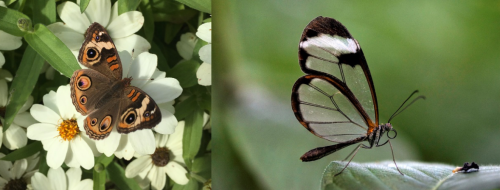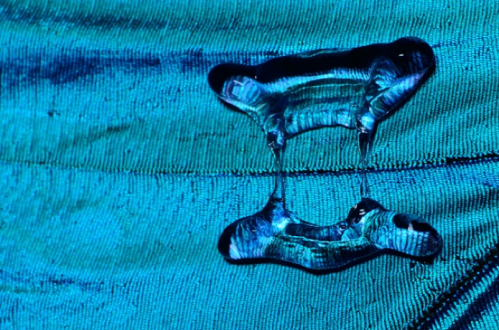A few weeks ago (before it started snowing!) I went on a walk in the garden across the street from the University of Wisconsin chemistry building and saw an abundance of beautiful butterflies. I noticed that the butterflies were iridescent in the sunlight as they fluttered from flower to flower. I wondered: does the iridescence have anything to do with nanostructures? Nanostructures are known to interact with light differently than their large-scale counterparts. I did a little research, and my intuition was right: in the case of butterflies, their wings contain evenly spaced layers of the biopolymer chitin that are separated by air. These nanostructures constructively reflect light to create iridescent color (you can read some of our earlier blog posts for more on butterfly nanostructures and color). Shiny butterfly colors are both beautiful and fascinating, but did you know that some butterflies have wings you can see through?

Glasswing (more formally Greta oto) butterflies have sections of their wings that are see-through. These “glass” sections confuse their predators while they fly. This property is called optical transparency, which means all the light that goes into the wing continues out the other side, just like with real glass. But what makes this possible? When you look at the transparent parts of a glasswing butterfly under a scanning electron microscope, you can see a lot of randomly sized nano-pillars. It is the random size and shape of the pillars that makes the glasswing butterflies transparent from any direction.2,3

Butterflies have nanostructures for other purposes too, like making their wings super water repellent and self-cleaning. Hydrophobicity is important for butterfly wings because it allows them to weather a rainstorm, where any moisture sticking to its wings could weigh down a butterfly and make it difficult to fly. Like the lotus effect, the nanostructures and microstructures on a butterfly wing make them hydrophobic and self-cleaning. Water droplets sit on top of the butterfly scale ridges, trapping pockets of air underneath. The water droplets don’t enter the hydrophobic pockets because the interactions between water molecules are stronger than the interactions between water and air.3,4,5 Also, the air pockets have an internal pressure that prevents water from permeating through. The wings of the blue morpho butterfly remove water even better than lotus leaves. Blue morpho butterfly wings have been shown to be some of the most hydrophobic materials in nature. To achieve super hydrophobicity, blue morpho butterflies have microscale ridges and veins that break a large drop of water into smaller droplets. The smaller droplets can leave the surface of the butterfly wing more quickly. 6

Butterfly wings also allow butterflies to sense their natural environment. Some butterflies can hear with their wings! The thick veins on a wood nymph butterfly wing can direct sound to the butterfly ear. The veins are inflated with air, which creates a gradient and may help the butterflies access low frequencies of sound. 7

Butterfly wings are magnificent! The unique properties of butterfly wings have served as inspiration for developing technologies. For example, simpler versions of the nanostructures that diffract light in blue morpho wings have been patterned onto banknotes to make bills more difficult to counterfeit. 8 The glasswing butterfly has inspired transparent glaucoma sensors with random nanopillars,9 and the superhydrophobic nanostructures that make butterfly wings self-cleaning have been proposed for use in marine applications to reduce drag and prevent fouling.10 Even the shape of butterfly wings is being studied to inform the design of flying micro-robots.11 I am constantly amazed at how beautiful butterflies have been used to inform so many advancements in technology, and I can’t wait to find out what’s next!
REFERENCES
- Horton, Jennifer. Where do butterflies get their striking colors?, HowStuffWorks.com, 2008.
- Siddique, R. H., Gomard, G., & Hölscher, H. The role of random nanostructures for the omnidirectional anti-reflection properties of the glasswing butterfly. Nature Communications, 2015, 6, 6909. doi: 10.1038/ncomms7909
- Han, Z., et al. Long-term durability of superhydrophobic properties of butterfly wing scales after continuous contact with water. Colloids and Surfaces A: Physicochemical and Engineering Aspects, 2017, 518, 139-144. doi: 10.1016/j.colsurfa.2017.01.030
- Zheng, Y., Gao, X., & Jiang, L. Directional adhesion of superhydrophobic butterfly wings. Soft Matter, 2007, 3(2), 178-182.doi: 10.1039/B612667G
- Stave, J. & Chen, C. Superhydrophobicity-The lotus effect. Teach Engineering STEM K-12, 2013.
- Bird, J. C., Dhiman, R., Kwon, H. M., & Varanasi, K. K. Reducing the contact time of a bouncing drop. Nature, 2013, 503 (7476), 385. doi: 10.1038/nature12740
- Sun, P., et al. In that vein: inflated wing veins contribute to butterfly hearing. Biology letters, 2018, 14 (10), 20180496. doi: 10.1098/rsbl.2018.0496
- Bittel, J. Counterfeit This: New Security Technology Inspired by a Butterfly. Slate, 2013.
- Narasimhan, V., Siddique, R.H., Lee, J.O. et al. Multifunctional biophotonic nanostructures inspired by the longtail glasswing butterfly for medical devices. Nature Nanotech, 2018, 13, 512–519 doi: 10.1038/s41565-018-0111-5
- Bixler, G. D., & Bhushan, B. Rice-and butterfly-wing effect inspired self-cleaning and low drag micro/nanopatterned surfaces in water, oil, and air flow. Nanoscale, 2014, 6(1), 76-96. doi: 10.1039/C3NR04755E
- Ortega Ancel, A., et al. Aerodynamic evaluation of wing shape and wing orientation in four butterfly species using numerical simulations and a low-speed wind tunnel, and its implications for the design of flying micro-robots. Interface focus, 2017, 7 (1), 20160087. doi: 10.1098/rsfs.2016.0087

“does the iridescence have anything to do with nanostructures?” That’s an interesting topic. lol
Great stuff, just excellent!